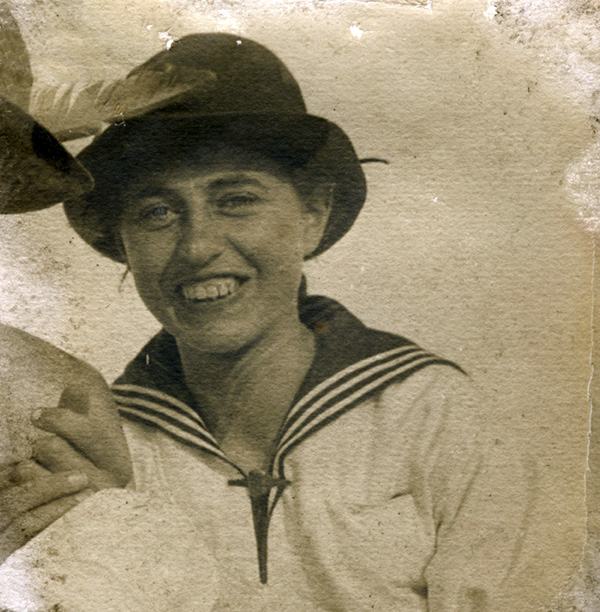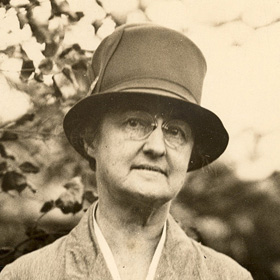Equality was the vision of Elizabeth Carter Brooks (1867-1951) in her work as educator, social activist and architect. Born in New Bedford in 1867 to the formerly enslaved Martha Webb, Elizabeth graduated from New Bedford High School and then continued her education in architecture at the Swain Free School of Design. She went on to study at New Bedford’s Harrington Normal School for Teachers, where she became its first African American graduate. In 1901, Elizabeth became the first African American woman hired as a public school teacher in New Bedford, and she taught at the Taylor School for over 25 years. She was also held leadership positions in the National Association of Colored Women’s Clubs and the NAACP.
Equality was the vision of Elizabeth Carter Brooks (1867-1951) in her work as educator, social activist and architect. Born in New Bedford in 1867 to the formerly enslaved Martha Webb, Elizabeth graduated from New Bedford High School and then continued her education in architecture at the Swain Free School of Design. She went on to study at New Bedford’s Harrington Normal School for Teachers, where she became its first African American graduate. Elizabeth began her teaching career at Howard’s Orphan Home, founded and run by African Americans in Brooklyn, New York. In 1901, Elizabeth became the first African American woman hired as a public school teacher in New Bedford. She taught at the Taylor School for over 25 years.
As a social activist who supported African American achievement, Elizabeth organized local, regional and national groups. She was very active in Black women’s club movement. While teaching in Brooklyn, she became the first recording secretary of the National Federation of Afro-American Women. Elizabeth also helped form the Northeastern Federation of Colored Women’s Clubs (NFCWC) and, from 1908 until 1912, she served as the fourth president of the National Association of Colored Women’s Clubs (NACW). As a leader in these organizations, she spearheaded many important efforts. She proposed the addition of a unit to the NACW that would lead boycotts to challenge discrimination. She petitioned the National American Woman Suffrage Association (NAWSA) for NFCWC membership, however NAWSA was not willing to let the Colored Women’s Clubs join. She pushed for the Senate’s adoption of the Dyer antilynching bill and helped lead a group of hundreds of women in an antilynching movement.
Elizabeth joined the National Association for the Advancement of Colored People (NAACP) soon after it was formed and later headed the NAACP’s regional and local New Bedford branches. Also in New Bedford, she organized the Elizabeth Carter Brooks Jr. Girls Club to preserve the history of African Americans through Friday afternoon meetings with young women.
Elizabeth’s work as an architect and real estate developer was grounded in her social activism. In 1897, she founded the New Bedford Home for the Aged and designed its permanent home on Chancery Street, where it opened in 1908. This was New Bedford’s first organized home for the elderly. At the request of the War Council of the YWCA’s national board, Elizabeth planned and supervised the building of the Phillis Wheatley YWCA, originally for colored women, in Washington, D.C. As a real estate developer, Elizabeth recognized the importance of preserving her city’s history. In 1939, she loaned money to the Martha Briggs Educational Club to purchase Civil War hero Sergeant William H. Carney’s home on Mill Street in New Bedford, where it remains under the stewardship of the Martha Briggs Educational Club.
In 1930, Elizabeth married Bishop William Sampson Brooks and moved to Texas for a short time, until his death in 1934. She returned to New Bedford after his death and continued her life’s work until her death in 1951. New Bedford Public Schools named the Elizabeth Carter Brooks School in her honor in 1957. Through her teaching, organizing and building, Elizabeth Carter Brooks enriched the lives of New Bedford’s students, elderly, and people of color.
Learn more about Elizabeth Carter Brooks in this story, which is part of the digital exhibit Organizing New Bedford: Women Who Mobilized Change.
Ann O’Leary, Emily Bourne Research Fellow
with Kayla Allen, Intern, University of Massachusetts Boston
Information from
-
“Elizabeth Carter Brooks.” Massachusetts Hall of Black Achievement, Item 19, Bridgewater State University, 1993, http://vc.bridgew.edu/hoba/19/.
-
“Elizabeth Carter Brooks.” New Bedford Historical Society, http://nbhistoricalsociety.org/Important-Figures/elizabeth-carter-brooks-1867-1951/.
-
Greene, Debra Foster. 2018. Biographical Sketch of Elizabeth C. Carter Brooks, 1867-1951. Alexandria, VA: Alexander Street. https://search.alexanderstreet.com/view/work/bibliographic_entity%7Cbibliographic_details%7C3935906.
![[Elizabeth Carter Brooks,1867-1951], Photograph, Courtesy of Martha Briggs Educational Club Bust image of Elizabeth Carter Brooks - woman with dark hair in an up-do, wearing a dark top with a dark ribbon around her neck and shrugging her shoulders.](https://historicwomensouthcoast.org/wp-content/uploads/2017/12/Elizabeth-Carter-Brooks-245x245.jpg)




